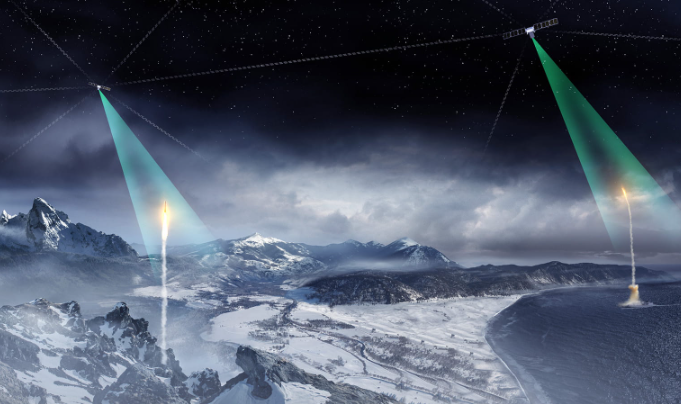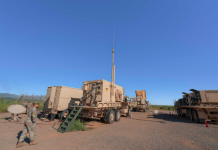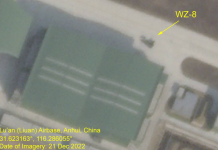WASHINGTON — The Space Development Agency is asking industry for feedback on a draft solicitation for a new prototype satellite constellation designed to provide “fire control” for ballistic and hypersonic missile defense.
The new “Fire-Control On Orbit-Support-To-The-War Fighter (FOO Fighter or F2)” program “will accelerate the ability to provide new fire control options for the tactical users,” an SDA spokesperson told Breaking Defense in an email. “The draft solicitation provides an opportunity for industry to review and offer feedback prior to final solicitation posting.”
SDA “plans to purchase and deploy” eight F2 space vehicles carrying electro-optical/infrared sensors “using more than one vendor,” the draft solicitation says. “SDA may also acquire additional satellites and sensor payloads under these OTAs [other transaction authorities] to inform requirements and constellation design.”
The F2 satellites represent a new, stand-alone program separate from SDA’s current effort to develop a “Tracking Layer” of missile warning/tracking satellites, some of which also will carry fire control capable sensors. Thus, the plan is likely to raise eyebrows from supporters of the Missile Defense Agency (MDA), including Rep. Doug Lamborn, R-Colo., chairman of the House Armed Service’s strategic forces subcommittee.
MDA since 2018 has been developing missile defense fire control sensors under the Hypersonic and Ballistic Tracking Space Sensor (HBTSS) program, and previous SDA moves to develop similar sensors already have sparked concerns that it is reinventing the wheel.
Fire Control Quality — In The Eye Of The Beholder
However, the term doesn’t have an agreed technical definition, at least in the case of missile defense, because it is relative to the interceptor’s own sensing capabilities. Missile tracking satellites relay tracking data to the interceptors to set them on their course. The interceptors then use their own sensors to plot the last leg of the journey, based on environmental (such as wind) and other conditions surrounding the target once the sensors are within close range.
The question of how to trade off the capability of space-based tracking sensors and that needed on interceptors is at the heart of the SDA-MDA debate, explained Masao Dahlgren, a CSIS associate fellow working with Karako.
“The performance of these tracking sensors directly influences the requirements for building a hypersonic interceptor; reduced track precision could make this task difficult or impossible. And they must interface with MDA-developed interceptors and networks,” he told Breaking Defense in an email.
One critical issue, the CSIS experts said, is the question of how many of SDA’s Tracking Layer satellites need wide field-of-view cameras to sweep large swathes of the skies for incoming missiles, versus medium field-of-view cameras that can cover less volume of space but can provide higher resolution images and better see dim hypersonic missiles. A related question is whether new wide field-of-view cameras can be developed with bolstered capabilities to track hypersonic missiles.
SDA Director Derek Tournear told the Mitchell Institute on April 5, that SDA plans to launch four satellites equipped with medium field-of-view cameras for precision tracking with fire control capabilities as part of its first operational Tracking Layer constellation for missile warning/tracking, called Tranche 1. The first Tranche 1 Tracking Layer launches are currently planned for April 2025.
The sensors on those four satellites are being developed using designs developed by MDA for HBTSS, which also are medium field-of-view cameras, according to SDA. However, they do not include the two MDA HBTSS sensors that are set to enter service later this year, nor are they exact duplicates.
SDA’s next set of Tracking Layer satellites, Tranche 2, is slated to launch in 2027 and to also carry a fire control sensor.
“The hopeful emphasis on fire control in Tranche 2 notwithstanding, questions still remain about whether it will be medium field-of-view, like HBTSS, or will instead try to do it with wide field-of-view,” Karako said.
As the more nascent FOO Fighter program is classified as Top Secret, the July 7 draft solicitation provides only basic details, so it is impossible to know what sort of fire control sensor is being imagined.
“A single launch strongly suggests that SDA will populate one orbital plane with these satellites. It is unclear if their payloads will share technical heritage with the HBTSS sensors and the derived medium field-of-view sensors envisioned for Tranche 2,” Dahlgren said.
Echoing the SDA spokesperson, the solicitation only says, “FOO Fighter or F2 system will accelerate the ability to provide fire-control in support of global detection, warning, and precision tracking of advanced missile threats, including hypersonic missile systems. The F2 system will demonstrate advanced missile defense capability by incorporating fire control-quality sensors into a prototype constellation.” (The term Foo Fighters was used by World War II pilots for unidentified flying objects seen during their sorties, as well as the name of a popular post-grunge band who were inspired by it.)
The SDA spokesperson told Breaking Defense that “[b]eyond the current special notice on Sam.gov, we have no additional information to share about the solicitation.”
The spokesperson, however, did confirm that the new program is “not related to the Tranche 1 (T1) or Tranche 2 (T2) Tracking programs, including the four T1 medium field of view satellites we plan to launch in 2025.” Further, the spokesperson added the “initial F2 launch” — which will include all eight satellites — is planned for the second quarter of fiscal year 2026.
Whither HBTSS?
Taken in total, the CSIS experts explained, SDA’s missile tracking plans leave the fate of the HBTSS unclear.
“Lo, be fearful of the valley of death,” Karako said.
And that is the very issue that led to the initial concerns of Lamborn and his colleagues, so the FOO Fighter program is more than likely to lead to additional congressional questions.
The House Armed Services Committee’s June 22 draft of the fiscal 2024 National Defense Authorization Act, states: “The committee is concerned that the transition of the program requirements to the Space Development Agency and resulting changes in the development and fielding plans could delay providing the global, persistent hypersonic missile defense fire control quality data that HBTSS was planned to provide to the warfighter.”
The language goes on to demand a Pentagon briefing no later than December 2023 on how the Missile Defense Agency will continue to be involved with fire control sensor development, as well as the build-out of the overarching missile warning/tracking satellite architecture, through the five-year future years defense program and beyond.





